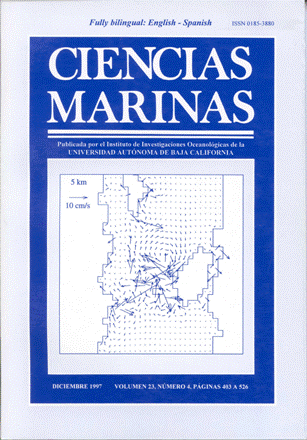Annual variation in size and reproductive phenology of the red alga Chondracanthus canaficufatus (Harvey) Guiry at Punta San Isidro, Baja California, Mexico
Main Article Content
Abstract
An intertidal population of Chondracanthus canaliculatus (Harvey) Guiry, a commercial carrageenophyte, was studied monthly from February 1993 to February 1994 on the northwestern coast of Baja California, Mexico. The thallus size (measured as maximum frond length) and the presence of cystocarps and tetrasporangial sori were determined for each sample of 450 thalli randomly collected at monthly intervals. The maximum average thallus size of 25.02 cm was recorded in June and the minimum average size of 11.22 cm was recorded in October. Size classes 4 to 8 (10 to 19.9 cm) were dominant throughout the year, except in June and July when size classes 10 to 14 (22 to 31.9 cm) reached their greatest values. We therefore propose class 8 as the minimum harvest size. There were two periods with high growth rates: the first in June and July in the larger size classes and the second in December and January in the smaller size classes. Cystocarpic thalli were more abundant in colder months (November to April) and tetrasporic thalli in warmer months (May to October). There is a high percentage of immature plants, so it is necessary to develop a method to determine the haploid or diploid characteristics of this alga.
Downloads
Article Details
This is an open access article distributed under a Creative Commons Attribution 4.0 License, which allows you to share and adapt the work, as long as you give appropriate credit to the original author(s) and the source, provide a link to the Creative Commons license, and indicate if changes were made. Figures, tables and other elements in the article are included in the article’s CC BY 4.0 license, unless otherwise indicated. The journal title is protected by copyrights and not subject to this license. Full license deed can be viewed here.

